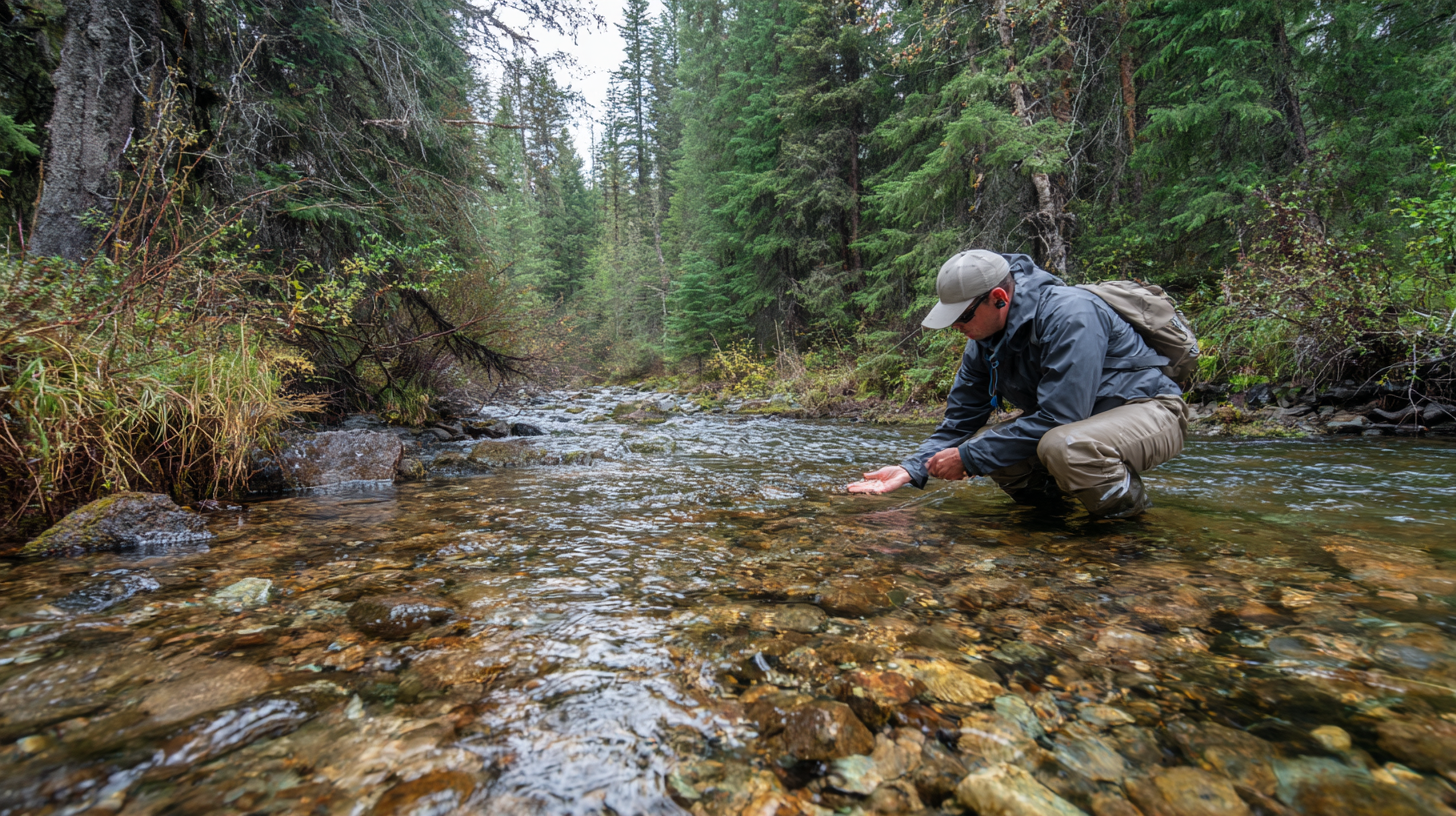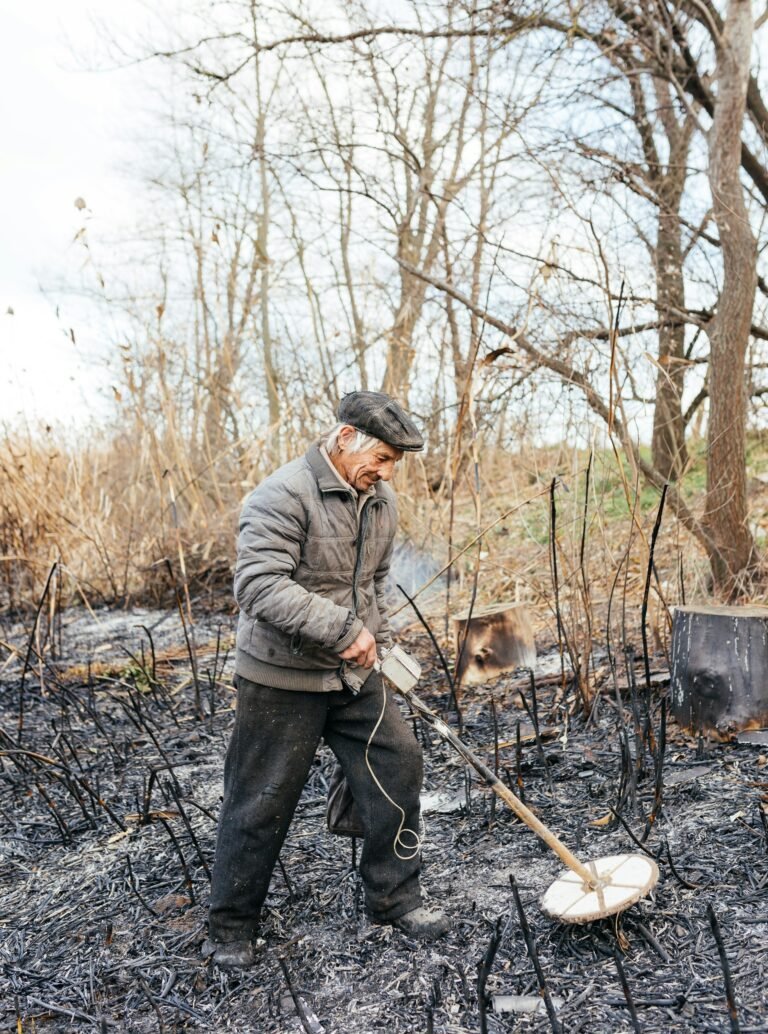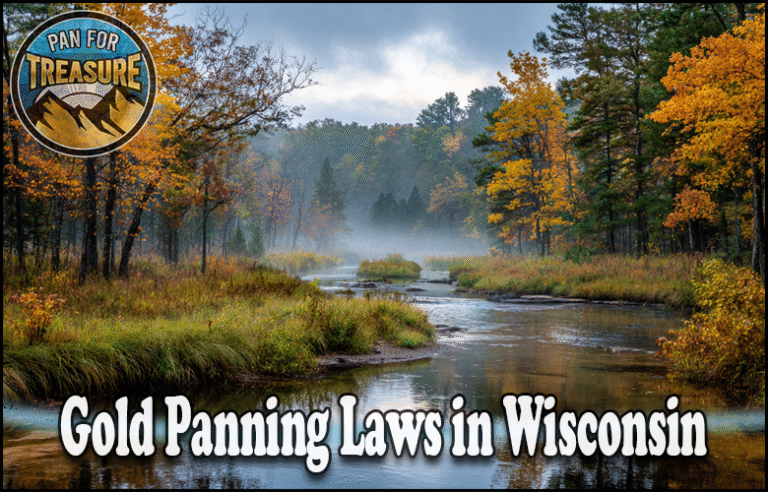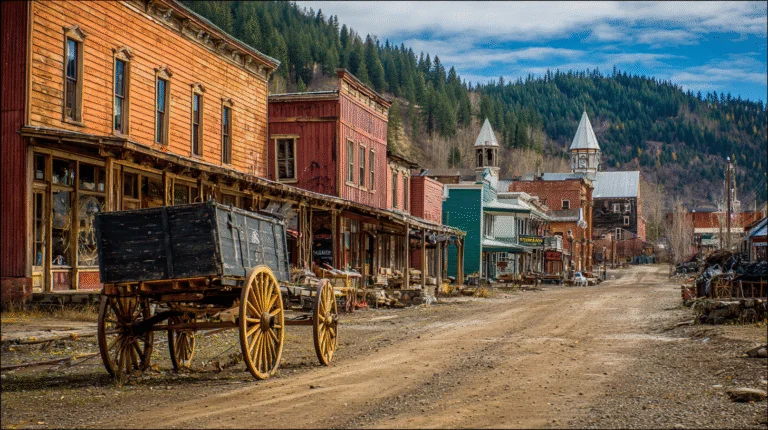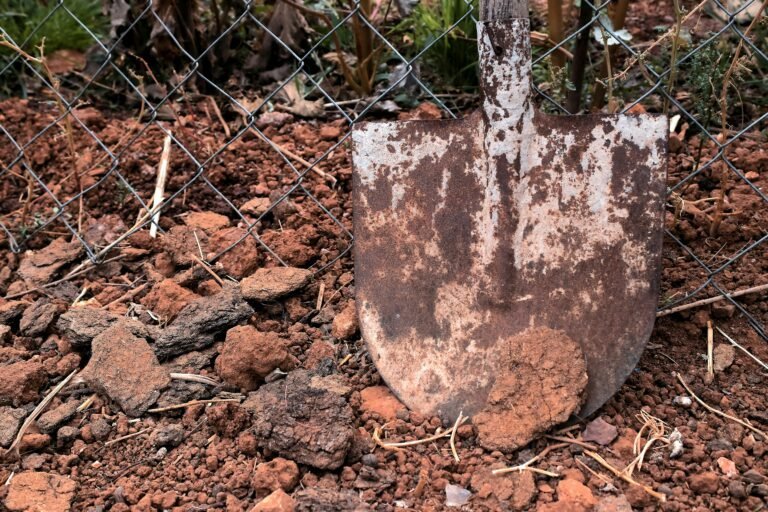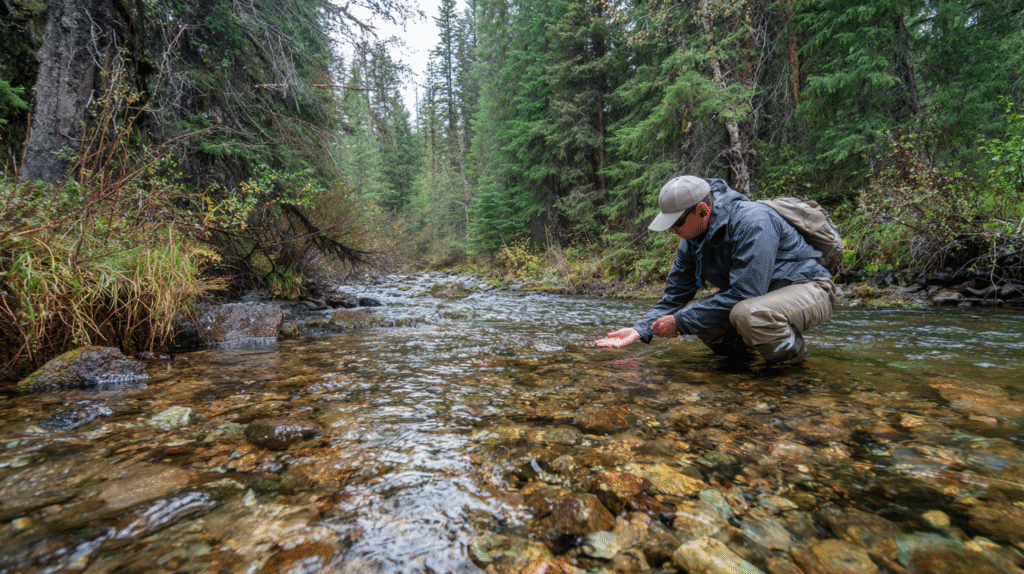
Disclosure: This Post Contains Affiliate Links; We earn a commission on purchases.
Wetland gold prospecting can be an exciting and rewarding adventure! However, before you grab your gear and head out, it’s important to understand the rules and regulations that govern these activities.
The U.S Army Corps of Engineers has regulatory authority over certain activities in waters of the United States, including wetland gold mining.
Their guidelines must be followed to ensure compliance and protect the delicate ecosystems that thrive in wetland areas.
To get started, it is highly recommended to consult with the Corps and obtain a preliminary or approved jurisdictional determination before embarking on any wetland gold prospecting activities.
This will help you understand the extent of waters of the United States at your chosen site and identify which aquatic resources fall under federal jurisdiction.
By familiarizing yourself with the rules and regulations, you can ensure a safe and responsible wetland gold prospecting experience.
So let’s explore the exciting world of wetland gold prospecting together!
Wetland Mining Opportunities and Deposits
Wetlands offer lucrative mining opportunities for gold prospectors. These unique ecosystems often harbor precious deposits of gold that have been transported and deposited by water over time. Geologically favorable conditions, coupled with hydrological processes, create the perfect environment for gold accumulation in wetlands. Prospectors can tap into this potential by conducting thorough research and identifying promising wetland mining opportunities based on geological surveys and historical data.
When it comes to wetland gold deposits, understanding the underlying geology is essential. Certain geological features, such as ancient river channels, placer deposits, or floodplain sediments, can indicate the presence of gold within a wetland ecosystem. By analyzing geological maps, mineral surveys, and past mining records, prospectors can gain valuable insights into potential gold-rich areas. Identifying areas with geological similarities to known gold-bearing sites can significantly enhance the chances of discovering profitable wetland gold deposits.
Factors influencing wetland gold accumulation:
- Topography and geomorphology
- Proximity to mineralized source areas
- Water flow patterns and hydrological dynamics
- Sediment composition and deposition
By considering these factors and conducting proper due diligence, prospectors can maximize their chances of uncovering significant wetland gold deposits. It is important to note that wetland mining requires careful observation and adherence to environmental regulations to protect these delicate ecosystems.
“By researching the geological characteristics of wetland areas and leveraging historical data, prospectors can unlock the potential of untapped gold deposits hidden within these unique ecosystems.” – Mining Expert
To gain a better understanding of wetland gold deposits, let’s take a closer look at a hypothetical geological survey conducted in a wetland area:
| Geological Survey Results: Wetland Area XYZ | Gold Concentration (grams/ton) |
|---|---|
| Placer Deposits: Ancient River Channel | 5.2 |
| Floodplain Sediments | 2.8 |
| Mineralized Source Areas: Upstream Tributaries | 3.6 |
Based on the survey results, the wetland area XYZ exhibits promising gold concentrations in both placer deposits and floodplain sediments. The presence of mineralized source areas in upstream tributaries further strengthens the potential for discovering gold deposits in this wetland. These findings provide valuable insights for prospectors wishing to explore wetland mining opportunities in this particular area.
Regulations for Wetland Gold Prospecting
When engaging in wetland gold prospecting, it is crucial to abide by the regulations set forth by the U.S Army Corps of Engineers. These regulations may vary depending on the specific location and jurisdiction. Prospectors should be familiar with the rules regarding activities such as gold panning in wetlands, wetland gold exploration, and other methods of extracting gold from wetland areas. It is also advisable to research and implement best practices for responsible and sustainable wetland gold prospecting to minimize environmental impacts.
Before embarking on any wetland gold prospecting activities, it is important to understand and comply with the regulations in place. The U.S Army Corps of Engineers has established guidelines to protect aquatic resources and ensure the responsible extraction of gold from wetlands.
Here are some gold prospecting tips for wetlands to help prospectors navigate the regulatory landscape:
- Familiarize yourself with the regulations specific to your location and jurisdiction.
- Obtain any necessary permits or authorizations required for wetland gold prospecting.
- Adhere to any restrictions or limitations on activities such as gold panning in wetlands or wetland gold exploration.
- Research and implement best practices for minimizing environmental impacts, such as using non-motorized equipment or hand tools.
- Consult with experts or experienced prospectors who can provide guidance on responsible and sustainable wetland gold prospecting techniques.
By understanding and following the regulations for wetland gold prospecting, prospectors can enjoy their activities while ensuring the preservation of these valuable ecosystems.
| Regulatory Requirements | Key Considerations |
|---|---|
| Obtain necessary permits | Comply with regulatory guidelines |
| Familiarize with restrictions and limitations on activities | Ensure responsible and sustainable extraction |
| Implement best practices for minimizing environmental impacts | Preserve the integrity of wetland ecosystems |
Wetland Delineation and Permitting Process
Before embarking on any wetland gold prospecting activities, it is crucial to understand the wetland delineation and permitting process. The U.S Army Corps of Engineers mandates the submission of wetland delineation reports to evaluate the extent of waters of the United States and assess potential impacts on aquatic resources.
These wetland delineation reports should provide comprehensive information about the survey area, including details about the aquatic resources present, hydrology, plant communities, and soil descriptions. By analyzing these reports, the Corps can better understand the ecological characteristics of the area and determine if any special precautions need to be taken to protect the wetland habitat.
“Wetland delineation reports help in understanding the extent and ecological importance of wetlands, allowing for informed decision-making in wetland gold prospecting activities.” – Dr. Emma Johnson, Wetland Ecologist
In addition to wetland delineation reports, prospective miners may also need to secure wetland mining permits, depending on the regulations in their specific jurisdiction. These permits typically require applicants to submit a proposed plan of operations outlining the nature and scope of the mining activities they intend to undertake in the wetland area. The Corps will review these plans and assess their potential impacts on the environment.
By diligently following the wetland delineation and permitting process, prospectors can ensure that their activities are environmentally responsible and compliant with the relevant regulations.
| Wetland Delineation and Permitting Process | Benefits |
|---|---|
| Submission of wetland delineation reports | – Enables a comprehensive understanding of wetland characteristics – Assists in identifying potential impacts on aquatic resources |
| Obtaining wetland mining permits | – Demonstrates commitment to environmental stewardship – Ensures compliance with regulations – Provides legal authorization for wetland gold prospecting activities |
Best Practices for Wetland Delineation
- Engage a qualified wetland delineation professional with expertise in your specific region.
- Thoroughly document all field observations, including photographs and detailed notes.
- Use recognized methodologies and protocols for wetland delineation to ensure accuracy and consistency.
- Consider conducting wetland delineation during periods of seasonal wetness to obtain a comprehensive understanding of hydrological conditions.
Understanding Wetland Mining Permits
- Research and familiarize yourself with the specific wetland mining permit requirements in your jurisdiction.
- Compile a comprehensive plan of operations that clearly outlines the proposed mining activities and measures to minimize environmental impacts.
- Consult with experts and regulatory agencies to ensure that your permit application is complete and meets all necessary criteria.
Environmental Considerations in Wetland Gold Prospecting
Responsible wetland gold prospecting involves employing extraction methods that minimize disturbance to the delicate ecosystems of wetland areas. By minimizing environmental impacts, prospectors can contribute to the preservation and sustainability of these valuable habitats.
One important aspect of minimizing environmental impacts is the selection of appropriate wetland gold extraction methods. Prospectors should prioritize the use of hand tools or non-motorized equipment whenever possible. These methods allow for precise control and reduce the potential for unintended damage to wetland ecosystems.
“By employing extraction methods that minimize disturbance to wetland ecosystems, prospectors can contribute to the preservation and sustainability of these valuable habitats.”
It is crucial to avoid or minimize the use of mechanized earthmoving equipment, as this can cause significant habitat disruption and soil erosion. Similarly, prospectors should avoid cutting trees in wetland areas, unless absolutely necessary. Trees provide essential ecosystem functions, such as carbon sequestration and habitat for wildlife, and their removal should be minimized to maintain the ecological balance of the wetland.
Furthermore, prospectors must ensure that any disturbances caused by wetland gold prospecting activities are restored and rehabilitated to their original condition. This includes carefully replanting vegetation, reestablishing hydrological patterns, and restoring soil stability. By restoring disturbed areas, prospectors can aid in the recovery of wetland ecosystems and minimize long-term environmental impacts.
Environmental Considerations in Wetland Gold Prospecting:
| Considerations | Action |
|---|---|
| Minimize disturbance | Use hand tools or non-motorized equipment |
| Avoid tree cutting | Only remove trees when absolutely necessary |
| Restore disturbed areas | Replant vegetation, reestablish hydrological patterns, restore soil stability |
“By employing these environmental considerations, prospectors can ensure the responsible and sustainable practice of wetland gold prospecting.”
By employing these environmental considerations, prospectors can ensure the responsible and sustainable practice of wetland gold prospecting. By minimizing disturbance, preserving tree cover, and restoring disturbed areas, prospectors can contribute to the long-term ecological integrity of wetland ecosystems, allowing for the coexistence of gold prospecting and environmental conservation.
Wetland Gold Prospecting and the Clean Water Act
Wetland gold prospecting activities in the United States are regulated under the Clean Water Act. This federal law prohibits the discharge of dredged or fill material into waters of the United States without a permit from the U.S Army Corps of Engineers. Wetland gold prospectors must obtain the necessary permits and abide by the rules and regulations set forth by the Corps. Failure to comply with these regulations can result in penalties and legal consequences.
When engaging in wetland gold prospecting, it is essential to understand the regulations and requirements outlined by the Clean Water Act. This act was enacted to protect the integrity of our nation’s water resources and ensures that wetland ecosystems remain unharmed during gold prospecting activities. By obtaining the appropriate permits and meticulously following the regulations, prospectors can help preserve the delicate balance of wetland habitats.
Collaboration with Regulatory Agencies and Experts
The successful and responsible practice of wetland gold prospecting requires collaboration with regulatory agencies and the guidance of wetland mining experts. Prospecting enthusiasts are strongly advised to consult with the U.S Army Corps of Engineers and other relevant regulatory authorities to ensure compliance with regulations and navigate the permitting process smoothly. By seeking the expertise of experienced wetland mining experts, prospectors can gain valuable insights and techniques for effective and responsible gold prospecting in wetland areas.
Consulting with Regulatory Agencies
Consulting with regulatory agencies, such as the U.S Army Corps of Engineers, is essential to understand and comply with the specific rules and regulations governing wetland gold prospecting. These agencies have valuable knowledge and expertise about the local ecological factors, permit requirements, and best practices. Collaborating with these agencies will ensure that prospectors are aware of all the necessary steps and legal obligations involved in wetland gold prospecting.
Seeking Guidance from Wetland Mining Experts
To optimize their chances of success and minimize environmental impact, prospectors should seek the advice and guidance of wetland mining experts. These experts have extensive knowledge about wetland ecosystems, gold prospecting techniques, and responsible mining practices. By leveraging their expertise, prospectors can gain insights into efficient extraction methods, minimizing disturbance to wetland habitats, and restoring impacted areas.
“Collaboration with regulatory agencies and access to expert guidance are crucial for ensuring both compliance with regulations and the development of sustainable wetland gold prospecting practices.”
By collaborating with regulatory agencies and seeking the assistance of wetland mining experts, prospectors can enhance their knowledge, skills, and understanding of wetland gold prospecting. This collaboration helps foster responsible and sustainable practices, protect the integrity of wetland ecosystems, and ensure the long-term preservation of these valuable natural resources.
| Benefits of Collaborating with Regulatory Agencies and Experts | Enhanced understanding of regulations | Access to specialized knowledge and expertise | Guidance in navigating the permitting process | Insights into responsible mining practices |
|---|---|---|---|---|
Potential Challenges and Limitations of Wetland Gold Prospecting
While wetland gold prospecting offers exciting opportunities, it is essential for prospectors to be aware of the challenges and limitations they may encounter in their endeavors. These challenges can significantly impact the success and sustainability of wetland gold prospecting activities.
Restricted Access to Wetland Ecosystems
One of the primary challenges of wetland gold prospecting is restricted access to these delicate ecosystems. Due to the ecological sensitivity of wetlands, access may be limited or regulated to protect the habitats and organisms that rely on them. This can make it challenging for prospectors to reach potential gold deposits and carry out their mining activities.
Potential Conflicts with Other Land Users or Stakeholders
Another challenge is the potential for conflicts with other land users or stakeholders in wetland areas. Wetlands often serve multiple purposes, such as water resource management, wildlife conservation, and recreational activities. These diverse interests may result in competing land uses or conflicting priorities, making it necessary for prospectors to navigate potential conflicts while conducting their gold prospecting activities.
Specialized Equipment and Expertise
Successful wetland gold prospecting requires specialized equipment and expertise. The unique characteristics of wetlands, such as the presence of water, soft terrain, and dense vegetation, may demand specialized tools and techniques. Prospectors may need to invest in equipment that can withstand the wetland environment and efficiently extract gold while minimizing environmental impacts. Additionally, expertise in wetland navigation, geological surveys, and gold extraction methods is crucial for maximizing outcomes in these challenging settings.
To overcome these challenges and limitations, prospectors should carefully assess the specific conditions and constraints of their target wetland areas. Developing appropriate mitigation strategies, collaborating with regulatory authorities, and seeking expert advice can help prospectors navigate through these challenges effectively. By being proactive and resourceful, prospectors can overcome these hurdles and increase their chances of success in wetland gold prospecting endeavors.
Continue reading to learn how wetland gold prospecting activities are regulated and the importance of collaboration with regulatory agencies and experts.
Safeguarding Wetland Ecosystems in Gold Prospecting
Responsible wetland gold prospecting is key to the conservation of the delicate ecosystems found in wetland habitats. Prospectors have an important role in preserving these valuable environments and minimizing the disturbances caused by their activities.
To safeguard wetland resources, prospectors should prioritize the following:
- Avoiding the destruction of vegetation: Prospectors must be mindful of the plant life that exists in wetland habitats. By taking precautions to limit damage to vegetation, such as using designated paths or minimizing trampling, their activities can have a reduced impact on the ecosystem.
- Minimizing soil erosion: Wetland habitats are often susceptible to soil erosion, which can negatively impact the overall health of the ecosystem. Prospectors should employ methods that minimize erosion, such as using sediment control measures and avoiding excessive digging or excavation.
- Proper disposal of waste materials: It is crucial for prospectors to responsibly dispose of any waste materials generated during their gold prospecting activities. This includes collecting and properly disposing of trash, ensuring no debris or hazardous materials are left behind in the wetland environment.
By adopting sustainable practices, such as minimizing disturbances, controlling erosion, and properly managing waste, prospectors can play a vital role in the conservation of wetland habitats while enjoying their gold prospecting endeavors.
Preserving the biodiversity and ecological balance of wetland ecosystems is essential for the long-term health and sustainability of these habitats. Responsible wetland gold prospecting ensures that future generations can continue to appreciate and benefit from the countless benefits wetlands provide.
| Benefits of Responsible Wetland Gold Prospecting | Actions |
|---|---|
| Conservation of wetland habitats | Adopting sustainable practices that minimize disturbances to wetland ecosystems |
| Maintaining biodiversity | Avoiding destruction of vegetation and minimizing soil erosion |
| Preserving ecological balance | Proper disposal of waste materials generated during gold prospecting activities |
Conclusion
Wetland gold prospecting presents both thrilling opportunities for treasure hunters and challenges in terms of regulations and environmental impacts. However, by understanding the rules and regulations, collaborating with regulatory agencies, and adopting responsible practices, prospectors can strike a balance between enjoying the potential rewards of wetland mining and preserving the integrity of these valuable ecosystems.
Approaching wetland gold prospecting with a commitment to sustainable stewardship is crucial. By following guidelines and obtaining the necessary permits, prospectors can ensure compliance with the Clean Water Act and minimize their environmental footprint. Responsible gold extraction methods and restoration of any disturbances caused during prospecting activities further contribute to the conservation of wetland habitats.
As we embark on wetland gold prospecting journeys, let us remember the importance of protecting and preserving these delicate ecosystems. By acting responsibly and striving to minimize our impact, we can continue to enjoy the excitement of treasure hunting while safeguarding the natural resources that make wetland mining possible. Together, we can ensure a sustainable future for wetland gold prospecting.
Source Links
- https://www.spk.usace.army.mil/Portals/12/documents/regulatory/jd/minimum-standards/Minimum_Standards_for_Delineation_with_Template-final.pdf
- https://www.portlandoregon.gov/bes/article/403466
- https://www.ecfr.gov/current/title-36/chapter-II/part-228

Meet Ryan Conlon, the passionate owner and driving force behind Pan for Treasure.
With an unwavering love for the art of gold panning, Ryan has transformed his enthusiasm into a thriving community hub for fellow treasure seekers. [email protected]
A seasoned gold panning enthusiast, Ryan’s journey began with a simple pan and a dream, evolving into a deep appreciation for the history, geology, and thrill of uncovering precious metals.
Subscribe to Our Newsletter

